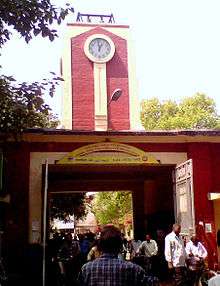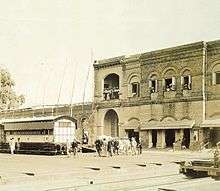Jamalpur Locomotive Workshop

Jamalpur Locomotive Workshop was established on 8 February 1862. Jamalpur Workshop was the first full-fledged railway workshop facilities in India, set up by the East Indian Railway.[1][2]
The Railway age in Eastern India started on 15 August 1854, exactly ninety-three years before Independence. A locomotive, carriage and wagon workshop was set up in Howrah to put to commission imported rolling stock of EIR and also to render economic repairs to them but it proved unsuccessful because of problems with procuring supplies and getting skilled labor. The railways spread very fast, perhaps faster than the anticipation of EIR. Within a short span of eight years it became necessary to shift the site of workshop, as there was hardly any scope for expansion at Howrah. And then Jamalpur Workshop was established at Jamalpur.
History

.
Jamalpur Workshop has enjoyed the distinction of being the largest and the oldest locomotive repair workshop with the most diversified manufacturing activities on the Indian Railways. At first the Jamalpur shops were merely repairing locomotives and also assembling locomotives from parts salvaged from other or damaged locomotives. By the turn of the century they had progressed to producing their own locomotives. In year 1899, CA 764 Lady Curzon was produced by the Jamalpur Workshop.[3] In 1893, the first railway foundry in India was set up at Jamalpur Workshop. It also had a boiler workshop for repairing and building boilers. A captive power plant of 5MVA was also developed in the Jamalpur Workshop. In 1870 it was equipped with a rolling mill of its own; unfortunately it’s not working at present. In addition to various repairs of wagons, coaches, cranes and tower cars, and locomotives, Jamalpur also undertakes repair and production of permanent-way fixtures. It also manufactures some tower cars such as Mark II, Mark III and break-down cranes of 10, 20, and 140 tone capacities, besides various kinds of heavy-duty lifting jacks.
Finally, it also manufactures wheel sets for coaches and wagons. Jamalpur workshop was a significant supplier of cast-iron sleepers as well. Starting in 1961 it produced several rail cranes. It has also produced electric arc furnaces, ticket printers. The high-capacity synchronized lifting jacks known as Jamalpur Jacks were also produced by this workshop.
The school attached to the Jamalpur workshops eventually became the IR Institute of Mechanical and Electrical Engineering.
Jamalpur as a site for EIR's Locomotive Workshops
The place was adjacent to Munghyr (now Munger), which was that time considered as Birmingham of the East. There was a plentiful supply of skilled mechanics from Munghyr, because inhabitants of Munghyr had been the mechanics by trade for centuries, famous for manufacturing of iron wares, guns, pistols, spears and other works.
When the selection was made it was probably thought that Jamalpur would be on the proposed mainline of EIR which was subsequently changed and was directed to Delhi via Ranigunj, Gaya, Mughalsarai, Allahabad and Kanpur. Initially, Jamalpur was only an engine changing station and light repairs were done in the running shed there. The original headquarters of the locomotive department of EIR was located at Howrah had a great draw back because it was too confined for extensions as and when needed. At Howrah, the original workshop was supposed to handle building of locomotives, carriage and wagons.
Vital Statistics
| Vital Statics of Jamalpur workshop | |
| Area | 5,74,654 sq. meters |
| Staff | 111,485 |
| No. of Machinery and Plants | 1628 |
| Power consumed | 7 MVA |
| Annual Turnover | Rs. 10.56 billion |
| Water supply | 7.3 million liters/day |
Achievements
- Jamalpur workshop is the only workshop in Indian Railways that has a captive Power house of 5 MVA
- The workshop has a number of FIRSTS in India to its credit,[4] a few of which are:
- The First to manufacture a steam locomotive and a locomotive boiler – 216 of which were manufactured between 1899 and 1923.
- The First to have set up a rolling mill not only on the railways, but probably in the country in 1870. It had 3 mills, steam driven Power hammer, fish plate machine, billet shears, the mill was driven by steam from boilers placed on the top of the furnaces and heated by gas from the furnaces. It produced about 400 tons of rounds, channels, angles and fishplates per month.
- The First to establish a railway foundry in the year 1893.
- The First to manufacture a rail crane in the country with indigenous know-how in 1961.
- The First to manufacture high capacity electrical lifting jacks and ticket printing, ticket chopping, ticket slitting and ticket counting machines.
- The First and the only railway workshop to manufacture electrical arc furnaces of ½ tonne capacity in 1961 for production of steel castings.
- The First to established Signal Equipment shop, more popularly known as "Points and Crossing and Interlocking shop" was started in 1894. produced entire requirement of Interlocking frames of different sizes for EIR
- The First and only to manufacture 140 Tonne Diesel Break-down Cranes.
Preserved JMP locomotives
Following are some of the preserved locomotives built by Jamalpur locomotive workshop marked as JMP:
| Class with number | Wheel arrangement (Whyte notation) |
Build date | Operational owner(s) | Disposition |
|---|---|---|---|---|
| GT 1057 | 0-8-0 | 1910 | EIR | Scrap India, 2/2 K.C. Roy Choudhury Road, Belur Math, Howrah - 711202 |
| CT 836 | 0-6-4 | 1906 | EIR | Scrap India, 2/2 K.C. Roy Choudhury Road, Belur Math, Howrah - 711202 |
| CA 34016 | 0-6-0 | 1901 | EIR then IR | Scrap India, 2/2 K.C. Roy Choudhury Road, Belur Math, Howrah - 711202 |
| DT 3530 | 0-6-2 | 1913 | N/A | Ramgarhia Polytechnic College, Phagwara |
IRIMEE
The Indian Railways Institute of Mechanical and Electrical Engineering (also known as IRIMEE) at Jamalpur is the oldest of the Centralized Training Institutions (CTIs) of Indian Railway.[5] IRIMEE started as a technical school attached to the Jamalpur Workshops in the 1900s, then the largest railway repair workshops in India. After the first World War, the technical school was greatly expanded for training of railway apprentices and supervisory staff involved with mechanical engineering. In the 1960s, a Diesel Traction Faculty was set up to conduct training courses and publish educational materials as IR engaged in desalinization.
In 1971 the school was renamed as the IRIMEE, and brought under the direct control of the Railway Board. In 1988 IRIMEE began conducting the various required courses for IRSME probationary engineers and various Mechanical Engineering staff. From 1997, IRIMEE has also been conducting various short-duration courses for other staff on various engineering topics. Topics include rolling stock and workshop technology, management science, and information technology aimed at officers and supervisory staff.
Current Activities
With the gradual eclipse of steam traction on Indian Railways, steam locomotive activities, which had peaked to 600 standard units per month in 1962-63, started declining in the late 60’s and finally the steam activities came to a complete end in August 1992. The shop kept pace with both, the technology change and technology up gradation on Indian Railways and diversified its activities to the Overhauling and Repair of Diesel Locomotives, Overhauling and Repair of various types of Wagons, Manufacture and Overhauling of Diesel Hydraulic Break Down Cranes up to 140 tonne capacity and Manufacture and Repair of various types of Tower Cars.
Apart from the above activity Jamalpur shops are also engaged following activities:
Periodical overhauling (POH) and repair of diesel locomotives
Periodical overhauling (POH) and repair of diesel locomotives at jamalpur workshop started in 1982 the workshop caters full demand of Eastern Railway. The Workshop also deals with Special repairs to accident involved locomotives and locomotives owned by various Public Sector Undertakings like NTPC, CPT, SAIL in the eastern region. So far 84 such Locomotives from PSUs have been repaired and generated a cash inflow of Rs. 26 crores.
Rebuilding and repair of BOX wagons
Due to generation of a large no of unloadable BOX wagons in Eastern Railway and thus limiting the usage of these wagons it was felt necessary to introduce special type of repair to BOX wagons in between POH to make them earn revenue. These scheme yielded results and Jamalpur shops gradually increased their production from 2445 FWUs in 95-96 to 3602 FWUs in 99-2000.
Manufacturing of 20 T crane
20 tonne Diesel Crane is a Rail Mounted, Diesel operated, BG (Broad Gauge) transportation crane. The crane is extensively used by Mechanical Department of Indian Railway in sick lines for maintenance of wagons/coaches and Transportation Department Indian Railway for handling of Goods.
First four 20T Diesel Crane was manufactured in 1980-81[6] with mechanical control system.
Later the control system was changed to Pneumatic as per RDSO Specification No. CR.D.122/90. Since 89-90 the shop has been manufacturing the 20 Tonne cranes as per this specification and has manufactured many such cranes.
Manufacturing of Jamalpur jacks
The Jamalpur jacks have been gaining in popularity chiefly due to low initial capital investment and minimum maintenance needs. It is worthwhile to mention that the performance and cost factor of these Jacks have posed a serious challenge to capital intensive Electrical Overhead Traveling Cranes.
Besides Indian Railways, these prestigious Jamalpur Jacks have been operating successfully at various steel plants and allied industries.
Special Features
The Jamalpur jack has a capacity to lift a load of 25 tonnes (24.6 long tons; 27.6 short tons)[7] and four such Jacks make one complete set with a total lifting capacity of 100 Tonnes. These Jacks can be operated simultaneously or individually.
Construction Features
The jack is rigid and robust. The upright column is fabricated and welded to the cast steel Gear Box. The elevating screw is provided with buttress thread supported with single-acting thrust ball-bearing having a spherical seating at the top and self-aligning ball-bearing at the bottom. This imparts self-aligning properties to the screw under loaded condition. The elevating screw is under tension when loaded and hence there is no chance of distortion due to buckling. While lifting the load, the Jack rests firmly on its base. For movement from one place to another, the lifting carriage is to be lowered by pressing the yoke which lifts the base and the Jack rests on the three wheels with a ground clearance of 20 mm.
Utility
Jamalpur jacks have been designed for:
- Lifting Diesel/Electric Loco for inspection and maintenance.
- Wheeling and de-wheeling in Sheds/Workshops/C&W Depot.
- Various other lifting purposes with suitable adaptors.
Tower cars
Jamalpur workshop is also involved in manufacturing of different tower cars such as Mark-II, Mark-III, Mark-IV, DHTC/JMP[8]
References
- ↑ Production Units & Workshops Indian railways fan Club website
- ↑ Official site of the Jamalpur Locomotive Works
- ↑ Chronology of railways in India, Part 2 (1870 - 1899), 1899 Indian railways fan Club
- ↑ jamalpur workshop
- ↑ IR Institute of Mechanical and Electrical Engineering Technical Institutions
- ↑ product of Jamalpur Locomotive Works
- ↑ Jamalpur jacks
- ↑ Tower cars
External links
| Wikimedia Commons has media related to Jamalpur Locomotive Workshop. |
- Official site of the Jamalpur Locomotive Works
- Report on Railway Budget 2004
- The Indian Railway Fan Club
- Genesis of the workshop (IRFCA site)
- History of Jamalpur Locomotive Works